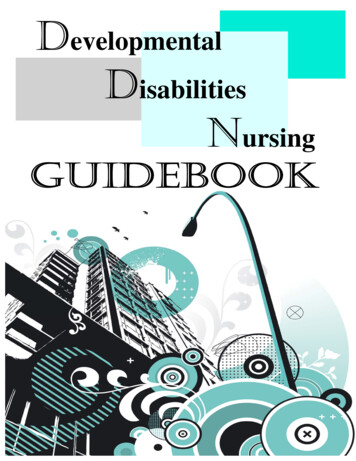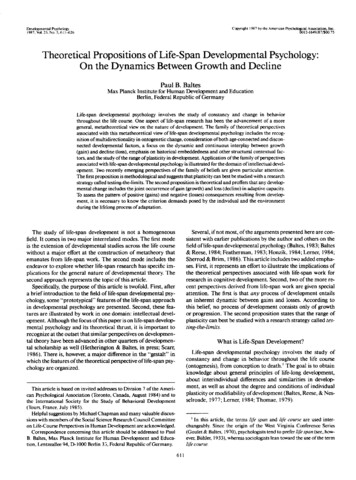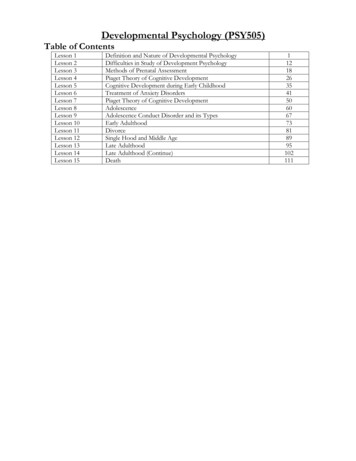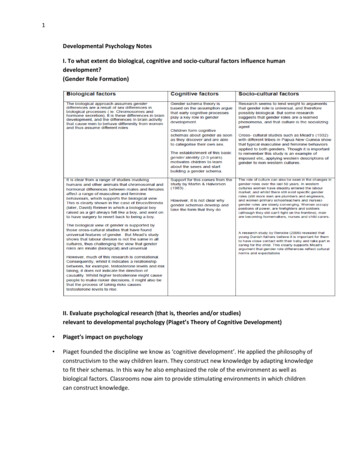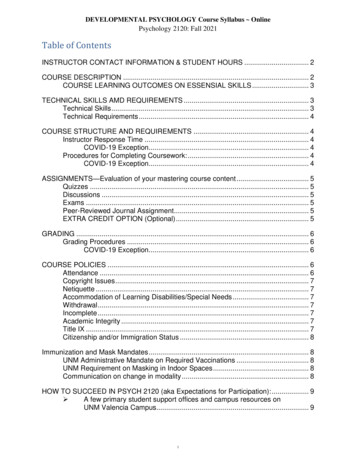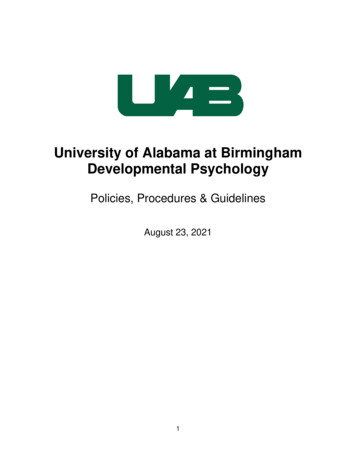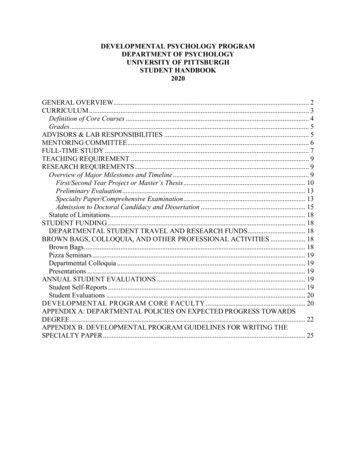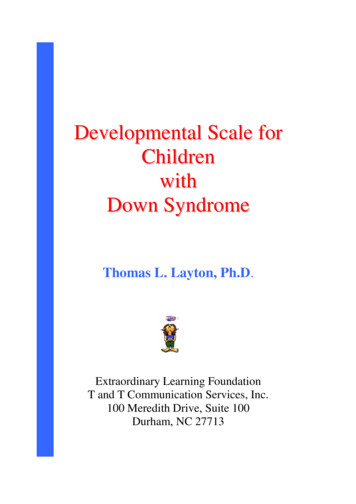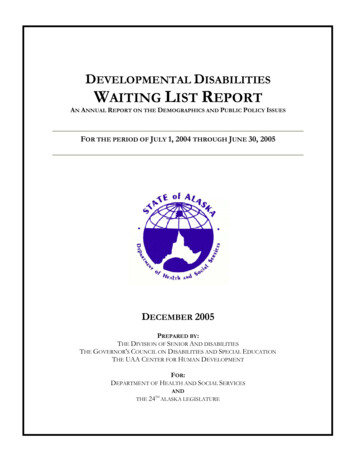
Transcription
DEVELOPMENTAL DISABILITIESWAITING LIST REPORTAN ANNUAL REPORT ON THE DEMOGRAPHICS AND PUBLIC POLICY ISSUESFOR THE PERIOD OF JULY 1, 2004 THROUGH JUNE 30, 2005DECEMBER 2005PREPARED BY:THE DIVISION OF SENIOR AND DISABILITIESTHE GOVERNOR'S COUNCIL ON DISABILITIES AND SPECIAL EDUCATIONTHE UAA CENTER FOR HUMAN DEVELOPMENTFOR:DEPARTMENT OF HEALTH AND SOCIAL SERVICESTHE 24THANDALASKA LEGISLATURE
TABLE OF CONTENTSPREFACE:ABOUT THE DEVELOPMENTAL DISABILITIES WAITING LIST REPORTSECTION 1:THE PURPOSE OF THE DEVELOPMENTAL DISABILITIES WAITING LISTSECTION 2:PLACEMENT ON THE LIST AND THE CRITERIA FOR RANKING ANDSELECTIONSECTION 3:BASIC DEMOGRAPHIC INFORMATIONSECTION 4:NEEDS, PREFERENCES, AND ESTIMATED COST TO SERVE INDIVIDUALS ONTHE WAITING LISTSECTION 5:NUMBER OF INDIVIDUALS SELECTED OR REMOVED FROM THE WAITINGLISTSECTION 6:NUMBER OF STUDENTS WITH DEVELOPMENTAL DISABILITIES IN SPECIALEDUCATIONSECTION 7:COPIES OF REPORTS, POLICIES, MANUALS, AND PROCEDURES2
PREFACE:ABOUT THE DEVELOPMENTAL DISABILITIES WAITING LIST REPORTUnder AS 47.80.130 (6)(d), the Department of Health and Social Services is required tooperate a Waiting List and provide an annual Waiting List Report to the Governor andspecified legislative committees when there is not adequate funding to meet the needs ofpeople with developmental disabilities who would be eligible to receive state-funded servicesunder AS 47.80.100 - 47.80.170. The full text of the statute governing generation of thisreport is found in attachment A and each Section of this report matches a specificrequirement in the law.As noted elsewhere in this report, Alaskans who experience developmental disabilities mayreceive a variety of services administered and funded by multiple federal, state and localagencies. No centralized database exists to easily determine what services, if any, a person onthe Waiting List is currently receiving, how services a client is receiving relate to the client’sneeds as expressed in the client’s Waiting List Criteria Assessment form, or whether theservices requested are needed immediately or may be needed sometime in the future.Therefore cost projections contained in this report should at best be considered estimates touse in planning and not a computation of the costs of comprehensive services that may benecessary to meet the needs of each person on the list.At the present time, the Division of Senior and Disabilities Services (DSDS) andstakeholders from the advocacy community are working together to redevelop the policiesand procedures that govern the management of the Waiting List. This committee iscurrently in the process of drafting recommendations to present to the Department ofHealth and Social Services in the spring of 2006. At the same time DSDS staff andindividuals from Central Information Technology (CIT) are working together to develop anew database, and tracking methodology for individuals on the waitlist.3
SECTION 1:THE PURPOSE OF THE DEVELOPMENTAL DISABILITIES (DD) WAITING LIST(AS 47.80.130 (6)(d)(1))The DD Waiting List is a tool used to gather information regarding people who have beendetermined eligible for developmental disability services and used to select people forenrollment in services when resources are available. Additionally, the DD Waiting List assiststhe Division of Senior and Disability Services in planning for the future needs of peoplehaving a developmental disability. At least annually, the Division contacts those on the Listto update personal information about changes in their condition or family circumstances.Eligibility for the Community Developmental Disabilities Grant (CDDG) program isdefined under the provisions of AS 47.80.900 (7). The term “developmental disability”means an individual with a severe, chronic disability that: Is attributable to a mental or physical impairment or combination of mental andphysical impairments; Is manifested before the individual attains age 22; Is likely to continue indefinitely; Results in substantial functional limitations in three or more of the following areas ofmajor life activity:- Self care;- Receptive and expressive language;- Learning;- Mobility;- Self-direction;- Capacity for independent living;- Economic self-sufficiency, and; Reflect the person’s need for a combination and sequence of special,interdisciplinary, or generic assistance, supports or other services that are of lifelongor extended duration and are individually planned and coordinated.4
SECTION 2:PLACEMENT ON THE LIST AND THE CRITERIA FOR RANKING AND SELECTION(AS 47.80.130 (6)(d)(2))In order for a person to be eligible for the DD Program they must fill out an EligibilityDetermination application. This form provides the information needed for aDD Program Specialist to determine eligibility. In addition to the Eligibility Determinationapplication, a Waiting List Criteria Assessment must also be completed.The Assessment asks about an individual’s current living situation, need for services, anddesired services. The questions attempt to measure immediate need and circumstances thatmight make a person vulnerable to crisis. A provider agency, Care Coordinator, or aRegional Program Specialist can assist a person or their family member with completingthese two forms. Once a determination of eligibility is made, the applicant is notified of theresults and placed on the DD Waiting List. The DD Waiting List is maintained in theCentral Office by staff located in Juneau, Alaska.If an individual’s life situation changes significantly, a revised DD Waiting List CriteriaAssessment may be submitted. Some types of life changes, such as the death of a parent orthe individuals declining health, may put the person at risk of institutionalization.Consequently, a “reassessment” may increase the original score.Scoring Criteria used for Managing the Waiting List (thru FY 05)A person’s DD Waiting List score is figured by adding the results of the Assessment ofNeed and the credit for the length of time a person is on the Waiting List. The maximumpoints from the DD Waiting List Assessment of Need are 225. For a total not to exceed 60points, an applicant also receives one point for each month they are on the list. Eachperson’s standing or rank on the list is relative to the scores of all others on the list.Consequently, a person’s rank order can change depending on the relative needs of otherson the Waiting List.In order to understand the scoring associated with Waiting List Criteria Assessments, referto the scoring definitions located after each of the five questions on the enclosedattachments. Twenty points are automatically awarded for question #5 about adequatesupports if no other questions are answered “yes.” An additional point is then awarded forthe first month’s wait time. The maximum number of points a consumer can receive is 285.This is only possible if the individual fully meets the criteria of all five questions and gets themaximum 60 points for their months on the list. The form uses a numerical assessment ofneed; consequently the higher the need, the greater the number of points given. Forexample: if the consumer is a documented threat to him/herself or others, homeless, oramong a category of individuals prioritized for services by a legislative appropriation, 100points are allocated toward the total score.Given the financial resources available to the Division of Senior and Disabilities time has notbeen a significant factor in determining an individual’s selection form the Waiting List. Theindividuals who have been selected from the Waiting List within the past year have beenpersons in crisis or with the highest immediate needs.5
DSDS has convened an Ad Hoc Waiting List Committee to review these procedures andmake recommendations on how to more equitably manage the Waiting List.Selection Methodology for Removing Persons on the Waiting ListUsing the method of ranking described above, selection from the DD Waiting List has beenhistorically based on who has the highest need and who has been on the list the longest. Thenumber of people selected is limited by the amount of appropriation from the legislatureincluding limits on enrollments in the MRDD Waiver. Besides an increase in legislativeappropriation, resources may become available when a person leaves the DD Program or afamily does not utilize all the resources allocated to them. Quarterly reviews are conductedwith DD providers and grantees to identify and allocate available funds to others in need ofservices.“Highest Need” can be defined as those consumers whose circumstances are determined torequire immediate and comprehensive long-term supports. After all else has failed,intermediate interventions have been tried, and the need for long-term care persists,individuals may be selected from the Waiting List according to the following “HighestNeeds” criteria that may place them at imminent risk of harm: Those who are in imminent risk of substantial harm or significant regression; An individual living in an unsafe or unhealthy circumstance; An individual whose medical or behavioral needs are creating a hazard; An individual without supports who is at risk of involvement with the JusticeSystem; An individual at risk of institutionalization in a psychiatric hospital, nursing home, orjail who would be unable to live in the community without supports, or; An individual living with a caregiver who no longer is able to continue in thatcapacity such as in the death of a parent.6
SECTION 3:BASIC DEMOGRAPHIC INFORMATION(AS 47.80.130 (6)(d)(3) & (AS 47.80.130 (6)(d)(6))The following demographic information represents that status of the Alaska DevelopmentalDisabilities Waiting List population during the State of Alaska fiscal year beginning July 1,2004 through June 30, 2005. Since the waitlist is a constantly revolving registry, this dataonly represents a snapshot of the waitlist during the specified time period and may not bereflective of the current state of the waitlist. Given historical precedent and the steadydemand for developmental disabilities services however, the waitlist data sees minimalvariance in population, geographic distribution, and demand for services over time.Therefore, the following data can be viewed with a high degree of reliability.All of the following data was culled from the Praxis database that the Division of Senior andDisabilities Services uses to maintain the Developmental Disabilities Waiting List. Thisinformation represents the most comprehensive and accurate information to date regardingthe Waiting List.Basic Data for Individuals on the Developmental Disabilities Waiting ListNumber of individuals on the list as of 6/30/2005:Number of individuals 22 years old or younger as of 6/30/2005:Number of individuals on the list for 90 days or moreAverage length of time for individuals on the Waiting List1,2331,0041,1423.1 yearsAge Ranges of Individuals on the Waiting ListTotalNumber .2%21.4% 1%100%TotalNumber e Range0 to 3 years of age4 to 17 years of age18 to 21 years of age22 to 64 years of ageOver 65 years of ageGender of Individuals on the Waiting ListGenderMale*Female* This statistic is consistent with statistics on the national prevalence rate of developmental disabilities among males and females.In general, there are more males with developmental disabilities than females.7
Race & Ethnicity of Individuals on the Waiting ListBecause race and ethnic background is not considered when determining eligibility fordevelopmental disabilities services or in the selection process from the Waiting List, theDivision of Senior and Disabilities Services have never collected this information. As aresult, we are unable to report the race or ethnicity at this time. In order to meet the mandateof AS 47.80.130 (6)(d)(3), the Division of Senior and Disabilities Services has begun tocollect data on the race and ethnicity of individuals on the Waiting List, and will be able toreport on this statistic in next year's Waiting List report.Geographic Distribution of Individuals on the Waiting List by Regional Service AreaDD Service RegionSouthcentral Region: includes Anchorage, Mat-Su,Kenai Peninsula, PW Sound, Kodiak, Aleutian Chain,and DillinghamNorthern Region: includes Fairbanks, the Interior,Bethel, and NW AlaskaPacific Coast Region: includes Cordova, Haines,Juneau, Sitka, south to KetchikanTotalNumber 3100%Services Received by Individuals on the DD Waiting ListAnalysis of program data indicates that in FY 2005, 565 (46%) individuals on the DDWaiting List received some services through the DD grants program administered by DSDS.Another 177 (14.4%) individuals received short-term assistance through the DSDSadministered Short Term Assistance and Referral (STAR) program.8
SECTION 4:NEEDS, PREFERENCES, AND ESTIMATED COST TO SERVE INDIVIDUALS ON THEWAITING LIST(AS 47.80.130 (6)(d)(4))One of the functions of the Waiting List assessment is to gather information on the servicesindividuals feel they will need. This data allows the state to rank individuals who have moreintensive service needs, project the cost for serving these individuals, and target Waiting Listdraws when a slot opens up for a specific service. The DD Program has developed an arrayof residential care ranging from supporting people in their own homes or the homes of theirparents, to out of home placements. A definition of each of the services provided by the DDprogram is included at the end of this report as Attachment C.Most people on the developmental disabilities Waiting List request more than one service,although there are some who have not requested any specific services. One of the servicecategories listed in the Waiting List database is “Unknown Service 11”. This service categorywas removed from the service list in the table below. 10 individuals were listed as needing"Unknown Service 11". There are also 342 individuals on the Waiting List that did notidentify a specific service that they needed. For this report, these two groups have beencombined for a total count of 352 individuals with unidentified service needs.Projected Annual CostBased upon the responses for types of services requested by persons when they complete aDD Waiting List Assessment, the following annual cost projection represents the Divisionof Senior and Disabilities Services' best estimate to serve all of the individuals on the WaitingList who indicated a service need(s), with the assumption that they would be served in theMedicaid Waiver program. Although it is well-documented that not all individuals on theWaiting List are eligible for waiver services, the Medicaid Waiver program service ratesprovide the most accurate cost data upon which to base budget projections.These cost projections should at best be considered estimates to use in planning and not acomputation of the costs of comprehensive services that may be necessary to meet the needsof each person on the list. In accordance with state law, the DD Program attempts to tailorservices to meet individual needs. Because the services that people receive are the result ofindividualized planning, determining the exact cost of meeting the needs of those on the DDWaiting List is difficult at best.The average annual costs listed in the following table represent an average of the rates forservice in FY 2004. Since rates were frozen in 2004, these cost estimates represent thecurrent cost of service with the following exceptions:1. 8.65 per day has been added to 24-hour care rates to reflect the recent regulatorychange in this service category.2. The Care Coordination service rate is calculated assuming that an individual receivesthis service for an entire year, and therefore represents a generous estimate of thecost of this service.3. Intensive Active Treatment (IAT) rates are variable depending upon the service,provider, and community in which the service is obtained. The IAT average is agood-faith estimate of the cost for this service.9
4. Respite and Chore service estimates have been calculated at the maximum allowedcost, and therefore represent a liberal estimate of the cost to provide these services.5. The Environmental Modifications cost represents the maximum allowable cost overthree years of service, with the presumption that the entire cost would be grantedduring the first year of service.6. The Residential Habilitation rate represents an average of the costs for all of the subcategories that fall under this service definition (e.g. Family Habilitation, GroupHome, In-Home Supports, Shared Care, and Supported Living). As such itrepresents an estimate of the cost for serving the 196 individuals who specified thisservice.7. There is no rate given for Specialized Equipment since the range of equipmentrequested and the demand for equipment is highly variable and does not lend itselfeasily to calculating an average cost.Services Requested by Individuals on the Waiting List and Projected CostAverageNumber ofType of Service RequestedAnnual CostRequestsResidential Habilitation 34,167196 30,7008- Family Habilitation 70,30014- Group Home 16,569210- In-Home Support 15,4149- Shared Care 37,854154- Supported LivingTotal Cost for All Requested Residential Rehabilitation ServicesRespite 12,673714Supported Employment 9,996351Day Habilitation 10,725289Care Coordination 3,150277Specialized EquipmentN/A159Intensive Active Treatment 5,000141Transportation 80693Environmental Modifications 10,00023Chore Services 8,98015Total CostTotal State Cost with FMAP at 50%Total State Cost with FMAP at 57%10TotalProjected Cost 6,696,732 245,600 984,200 3,479,490 138,726 5,829,516 17,374,264 9,048,522 3,508,596 3,099,525 872,550N/A 705,000 74,958 230,000 134,700 35,048,115 17,524,058 15,070,689
SECTION 5:NUMBER OF INDIVIDUALS SELECTED OR REMOVED FROM THE WAITING LIST(AS 47.80.130 (6)(d)(5))The following table represents the individuals removed from the Waiting List in FY 2005.Number of Individuals Removed From the Waiting List in FY 2005Reason for Removal2004 Waiting List survey never returnedMoved to another stateRequested to be removedSelected for waiver servicesNeeds met by another DD programDeceasedNon-responsive to division staffNot eligible for DD servicesTotalNumber of Individuals606*11963**8443705* It is the responsibility of the applicant to keep DSDS informed of their current contact information. Should someone be selectedfrom the Waiting List for comprehensive services and fail to respond to notification, they can be removed from the list. If theseapplicants eventually contact DSDS after a prolonged absence from the state or after being taken off the list they may, with properdocumentation, be placed back on the list as of the original date they were first deemed eligible for DD services. Many people havere-secured placement on the list under these conditions.**Although 60 individuals have been selected for MRDD services only 49 Plans of Care have been submitted to DSDS at thepresent time.During FY 05, the DD Program selected a total of 63 consumers from the DD Waiting Listfor comprehensive services or long-term care. Those who were selected had the highestscores on the Waiting List because a crisis situation placed them at risk of harm that couldnot be addressed with short-term assistance measures. There were also 8 individuals whowere removed from the List after their needs were met by other programs.Other individuals were removed from the List for various reasons such as moving to anotherstate (11) or they died (4) as a result illness or accident unrelated to their needs for morecomprehensive services or long term care.11
SECTION 6:NUMBER OF STUDENTS WITH DEVELOPMENTAL DISABILITIES IN SPECIAL EDUCATION(AS 47.80.130 (6)(d)(7))It is important to note that Special Education and the services provided through the DDPrograms are different. Special Education provides specially designed instruction by in theschool setting. Local education authorities under the purview of the Alaska StateDepartment of Education and Early Development (DEED) administer these programs.The DD Program provides for services and supports in the home or community to assist theindividual and their family to participate in community life and avoid institutional placement.Another key distinction between special education and the DD program is that, for thosewho qualify, Special Education is an entitlement; but the DD Program operates within thelimits of annual legislative appropriations and the capacity of the state and community toprovide the desired services.According to the Department of Education and Early Development (DEED) there areabout 18,000 students age 3 to 22 in Special Education. Among these Special Educationstudents, approximately 4000 may have developmental disabilities. Individuals with thefollowing types of developmental disabilities may be receiving special education servicesacross the state: mental retardation, cerebral palsy, autism, and seizure disorder. Similarly,children with a severe emotional disorder or Fetal Alcohol Syndrome may qualify as having adevelopmental disability if they experience substantial limitations in function.The numbers below reflect DEED categories for students with Autism, Mental Retardation,Traumatic Brain Injury, & Multiple Disabilities.As of December 15, 2005, the Department of Education and Early Development reportsthat:- The number of students in Special Education with developmental disabilitiesgraduating from high school with a regular diploma was 61;-The number of students in Special Education with developmental disabilitiesdropping out of high school by age 22 was 14, and 3 students aged out of specialeducation services; and-The number of students in Special Education with developmental disabilitieswho by age 22 do not graduate from high school with a regular diploma butreceive Certificate of Completion was 31.12
SECTION 7:COPIES OF REPORTS, POLICIES, MANUALS, AND PROCEDURES(AS 47.80.130 (6)(d)(8))Copies of this report and the forms used to manage the Waiting List are available on theWebsite of the Division of Senior and Disabilities Services opies of this report, policies, and forms used to manage the Waiting List may also beobtained by requesting them from the Division of Senior and Disabilities Services at thefollowing address or phone number:The Division of Senior and Disabilities ServicesP. O. Box 110680Juneau, Alaska 99811-0620(907) 465-3165orToll Free at 1-866-465-316513
developmental disabilities waiting list report an annual report on the demographics and public policy issues for the period of july 1, 2004 through june 30, 2005 december 2005 prepared by: the division of senior and disabilities the governor's council on disabilities and special education the uaa center for human development for: department of health and social services

